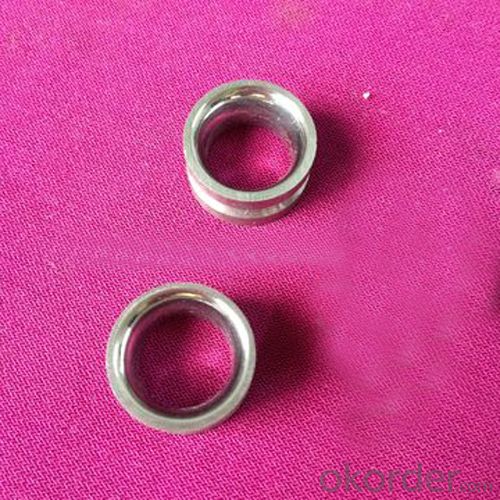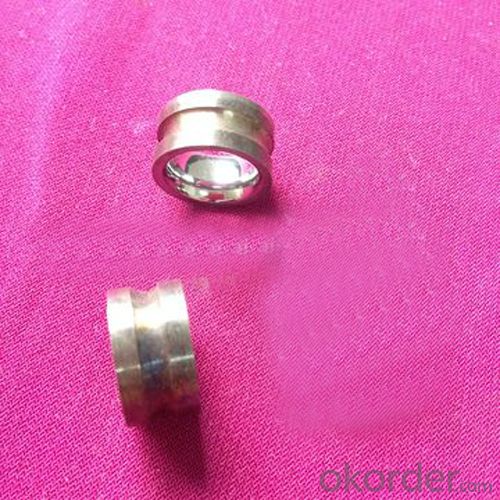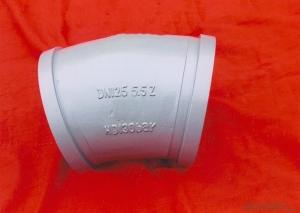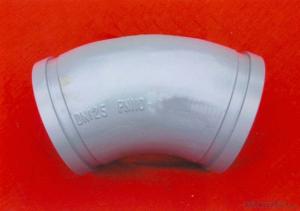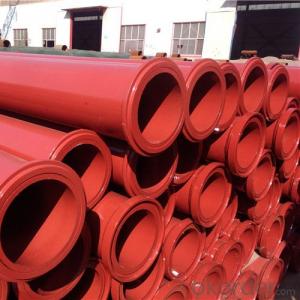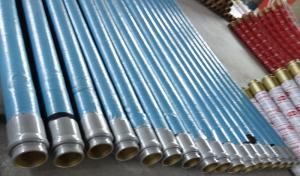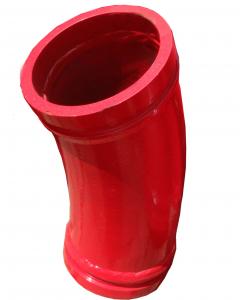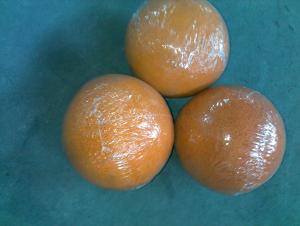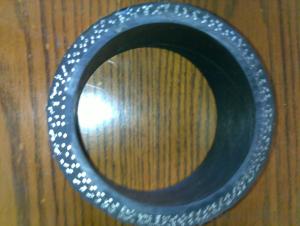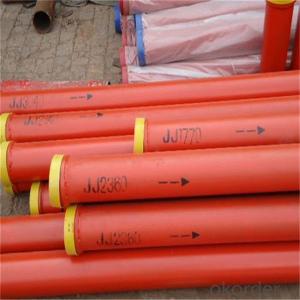Carbide Round Wire Guide for Textile Industry
- Loading Port:
- Shanghai
- Payment Terms:
- TT OR LC
- Min Order Qty:
- 1 pc
- Supply Capability:
- 1000 pc/month
OKorder Service Pledge
OKorder Financial Service
You Might Also Like
Description:
Made by high purity carbide raw material, good abrasive resistance.
After accurate grinding and polishing, the friction factor of surface is very low.
High-precision technical equipment
Applications:
The carbide balls are widely used in where extreme hardness and wear resistance is required, such as bearings, ball screws, valves and flow meters, pen, spraying machines, pump, machinery parts, oil, hydrochloric acid lab, hardness measuring instrument and more high-end industry
Diameters:
Dia. 2, 5, 7, 8, 10, 12mm (or 5/8, 3/4, 15/16, 1-1/8, 1-1/4, 1-3/8, 1-1/16, 2-1/4") and more.
Quick details:
Place of origin: Zhuzhou, China
Chemical composition: WC + cobalt
Surface color: blanks ungrounded of grinding polished
MOQ:
Can be 100 pieces or 1kg
But the price will be a little bit high when the quantity is below 50kg or 2000USD
Packing:
First in plastic bag, 1 bag/paper box, 20 boxes/ctn
According to customer's demand
Sample:
Samples are available upon customers' request
Sample lead time is 7 days
Sample sent by DHL,UPS,FEDEX, EMS, China Post Airmail and more
Delivery lead time:
For standard types, delivery lead time is normally 20-25 days.
For nonstandard type or further processed type, delivery lead time is 25-35 days
For urgent needs, delivery lead time may be pushed by negotiation
Payment methods:
T/T, 30% deposit, balance payment before shipment
Other payment methods such as PayPal, Western Union, L/C are negotiable
Other services:
OEM and ODM are welcome
Customized designs welcomed
Experienced staffs will reply to your inquiry within 24 working hours
Details:
Rade | Density | Hardness | T·R·S (MPa) | Application Recommended |
YG4C | 15.00 | 89.5 | 1800 | Mainly used as small buttons for percussion bits and as the inserts of rotary prospecting bits to cut soft, medium-hard formations |
YG8 | 15.8 | 89.5 | 1700 | Mainly used as the buttons of small and medium-sized percussion bits and as the inserts of rotary prospecting bits to cut soft, medium-hard formations |
YG8 | 14.7 | 88.5 | 2300 | Mainly used as the buttons of small and medium-sized percussion bits and as the inserts of rotary prospecting bits to cut soft, medium-hard formations |
YG8C | 14.7 | 88.0 | 2300 | Mainly used as the buttons of small and medium-sized percussion bits and as the inserts of rotary prospecting bits to cut soft, medium-hard formations |
YG9C | 14.5 | 87.0 | 2400 | Mainly used as the inserts and buttons for rotary-percussive bits, coal-cutting bits and tricone bits to cut medium-hard and hard formations |
YG11C | 14.4 | 86.5 | 2450 | Chiefly for the inserts and buttons of heavy rock drill bits and rotary-percussive bits, coal-cutting bits and tricone bits to cut medium-hard and hard formations |
YG13C | 14.3 | 86.0 | 2500 | Mainly used as the inserts and buttons of tricone bits rotary-percussive bits and heavy rock drill bits to cut medium-hard and hard formations |
YG15 | 14.00 | 86.5 | 2500 | It is stronger, and is mainly used as the inserts and buttons of rotary-percussive bits, heavy rock drill bits to cut hard and very hard formations |
YG16 | 14.10-14.30 | 87.5 | 2400 | It is mainly used for making cemented carbide substrate tips to be used in PDC cutters for excavating coal and oil field PDC bits |
YG20 | 13.40-13.70 | 85.0 | 2254 | Mainly for the stamping dies used in the conditions of heavy impact load and large strees |
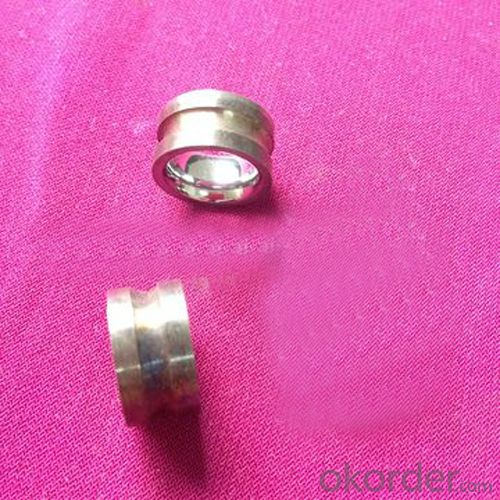
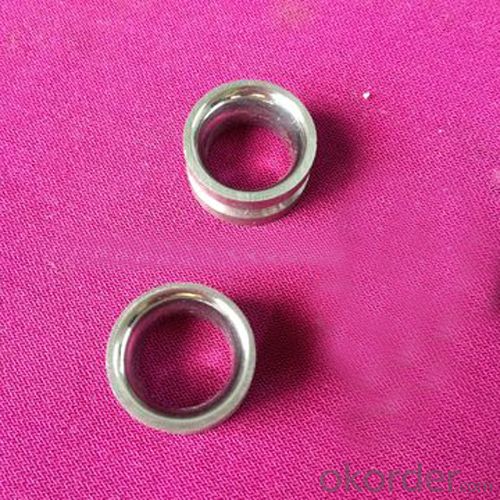
- Q: How can one identify the correct type of rubber seals or gaskets for concrete pump spare parts?
- To identify the correct type of rubber seals or gaskets for concrete pump spare parts, one should consider several factors. Firstly, it is important to know the specific model and make of the concrete pump to ensure compatibility. Additionally, one should evaluate the application requirements, such as the pressure and temperature conditions the seals or gaskets will be exposed to. Considering the material compatibility with the fluids or chemicals being pumped is also crucial. Consulting the manufacturer's specifications or seeking expert advice can provide further guidance in identifying the correct type of rubber seals or gaskets for concrete pump spare parts.
- Q: Can concrete pump spare parts be painted or coated for increased durability?
- Concrete pump spare parts can achieve greater durability by undergoing painting or coating. This protective measure shields them from corrosion, wear, and other types of harm. Applying a layer of paint or coating enhances their resistance against harsh environmental conditions, chemicals, and moisture. Furthermore, certain paints or coatings can provide extra advantages like heat resistance or non-stick properties, further bolstering the spare parts' durability and performance. It is crucial to utilize appropriate paints or coatings that are specifically formulated for the materials and conditions the spare parts will encounter, guaranteeing optimal adhesion and longevity.
- Q: How does a concrete pump S valve function?
- Controlling the flow of concrete from the hopper to the discharge outlet is the primary function of the S valve in a concrete pump. This valve is a critical component in the concrete pumping system, enabling the accurate and efficient delivery of concrete to the intended destination. The S valve comprises two distinct valves, one on each side, connected by a central shaft. These valves are shaped like the letter "S," hence the name. Each valve possesses a concrete outlet and a hydraulic cylinder that governs its movement. When the concrete pump is activated, the hydraulic system exerts pressure on the cylinders, causing them to extend and open the valves. This opening enables the flow of concrete from the hopper into the pump's cylinder. Once the concrete enters the cylinder, the hydraulic system reverses the pressure on the cylinders, prompting them to retract. This retraction movement closes the valves, effectively sealing the cylinder and preventing any concrete from flowing backward. As the cylinder retracts, it propels the concrete towards the discharge outlet. The pressure generated by the cylinder's retraction forces the concrete through the outlet pipe, directing it to the desired pouring location. The ingenious design of the S valve ensures a seamless and uninterrupted flow of concrete, eliminating any potential interruptions or obstructions. Moreover, it grants operators a high level of control over the concrete placement, enabling them to adjust the flow rate and direction according to their requirements. In conclusion, the concrete pump S valve assumes the crucial role of regulating the concrete flow, guaranteeing its efficient and precise delivery to the intended destination. Its dependable and effective operation is indispensable for the success of concrete pumping operations.
- Q: Can I get spare parts for concrete pump hopper agitators and vibrators?
- Yes, spare parts for concrete pump hopper agitators and vibrators are generally available. These parts can be sourced from various manufacturers and suppliers specializing in construction equipment and machinery. It is recommended to contact the manufacturer of the concrete pump or the authorized dealer to inquire about the availability and pricing of spare parts for the hopper agitators and vibrators. Additionally, there are also online platforms and marketplaces that offer a wide range of spare parts for construction equipment, including concrete pump components. It is important to provide specific details about the make and model of the concrete pump to ensure compatibility and proper functioning of the spare parts.
- Q: What is the function of a concrete pump control lever?
- The function of a concrete pump control lever is to control the flow and direction of the concrete being pumped. It allows the operator to start and stop the pump, adjust the speed of the pump, and control the placement and placement speed of the concrete. The control lever also enables the operator to switch between different pumping modes, such as pumping vertically or horizontally, and adjust the pressure of the concrete being pumped. Overall, the control lever is essential in ensuring accurate and efficient concrete pumping operations.
- Q: How often should concrete pump seals be replaced?
- Concrete pump seals should be replaced every 500 to 800 hours of operation or whenever signs of wear, leakage, or decreased performance are observed.
- Q: What are the causes of pipe blockage in concrete pump?
- Therefore, in the JGJ/T10-95 "concrete pumping construction technical regulations," stipulated that the sand through the 0.315mm sieve shall not be less than 15%.
- Q: What are the different types of concrete pump rubber hoses?
- In the market, you can find a variety of concrete pump rubber hoses. These hoses come in different types to cater to specific needs. The first type is the Steel Wire Reinforced Hose, which is the most commonly used. It is built with multiple layers of steel wire to provide maximum strength and durability. This type of hose is suitable for high-pressure applications and can handle the heavy pumping of concrete effortlessly. Another type is the Textile Reinforced Hose, which is reinforced with multiple layers of textile fabric like nylon or polyester. These hoses are lighter in weight compared to the steel wire reinforced ones, making them easier to handle and maneuver. They are suitable for medium-pressure applications and are commonly used in smaller concrete pumps. Then there is the Fabric Hose, which is made from a single layer of fabric like nylon or polyester. These hoses are lightweight and flexible, making them easy to handle and transport. Fabric hoses are suitable for low-pressure applications and are commonly used in small-scale construction projects. Composite Hoses are made from a combination of different materials such as rubber and plastic. These hoses are lightweight and highly flexible, which makes them ideal for applications where maneuverability is crucial. They are commonly used in smaller concrete pumps and can handle both low and medium pressure. Lastly, there are Flanged Hoses, which have flanges attached at both ends. These flanges are used to connect the hose to the pump and the nozzle, providing a secure connection and preventing any leaks or disconnections during the pumping process. Flanged hoses are commonly used in high-pressure applications and are suitable for large-scale construction projects. In conclusion, the choice of concrete pump rubber hose depends on specific project requirements. Factors such as pressure, size, and type of concrete being pumped should be considered to ensure efficient and safe concrete pumping operations.
- Q: What are the safety measures to consider while replacing concrete pump spare parts?
- When replacing concrete pump spare parts, there are several important safety measures to consider. Firstly, it is crucial to ensure that the pump is turned off and all power sources are disconnected before beginning any work. Additionally, wearing appropriate personal protective equipment, such as gloves, safety glasses, and steel-toed boots, is essential to protect against potential hazards. It is important to follow the manufacturer's guidelines and instructions for replacing the specific spare part to ensure proper installation and prevent accidents. Lastly, maintaining a clean and organized work area, free from clutter and debris, can help prevent trips and falls while working on the pump.
- Q: What are the indications of a clogged or damaged concrete pump filter?
- Some indications of a clogged or damaged concrete pump filter include decreased pumping pressure, reduced flow rate, increased fuel consumption, and irregular or inconsistent concrete output. Additionally, if the concrete pump filter is severely clogged or damaged, it may cause the pump to overheat or shut down completely. It is important to regularly inspect and clean or replace the filter to ensure optimal performance and prevent any potential damage to the pump.
Send your message to us
Carbide Round Wire Guide for Textile Industry
- Loading Port:
- Shanghai
- Payment Terms:
- TT OR LC
- Min Order Qty:
- 1 pc
- Supply Capability:
- 1000 pc/month
OKorder Service Pledge
OKorder Financial Service
Similar products
Hot products
Hot Searches
Related keywords




